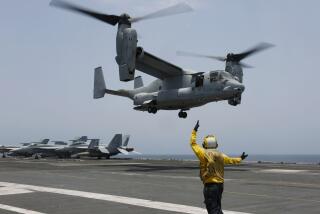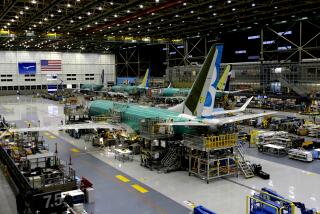Lockheed Sued by 3 in Firings
Three former Lockheed Corp. quality control auditors filed a $15-million lawsuit against the company Thursday, claiming that they were fired after they turned up dangerous defects in the metal main frame of the giant C-5B military cargo plane.
Lockheed management refused to conduct tests on the weakened metal and falsified records to make it appear as though the tests had been performed, according to the lawsuit filed in Los Angeles Superior Court.
At the same time, Lockheed officials were aware that defects could lead to a “catastrophic failure” of the aircraft, designed as the nation’s largest aerial troop and cargo carrier, the lawsuit stated.
Lockheed spokesman Rich Stadler, however, said company officials were aware of the metal fatigue problem long before the three employees raised the issue and had promptly corrected it.
“Following the Air Force’s confirmation that the difficulty was remedied and no safety problem existed, production of parts continued,” Stadler said.
The Air Force ordered 50 C-5Bs in 1982 for a total of $7.8 billion. The first were delivered in 1985.
In their lawsuit, Thomas Benecke and Terrence Schielki, both internal audit supervisors, and Clyde Jones Jr., a product assurance supervisor, said they learned during a routine quality control audit that the ovens used to heat treat the metal main frame parts were much hotter than they should have been. The men worked at company facilities in Burbank and Palmdale.
Sometime later, drillers assembling the plane began complaining that state-of-the-art drill bits were breaking when used on some parts of the main frame. In other parts, the drills were plunging through metal that clearly was too soft, they said.
Early in 1984, the three men brought their concerns to the attention of management and suggested an investigation, a suggestion which was “summarily rejected,” they said.
The following year, they learned that periodic tests required under military specifications, tests which would have shown up any metal fatigue problems, were not being conducted. After their complaints, records were altered to indicate that the tests had been performed, when they had not, they alleged.
Becoming more concerned, the three sent metal scraps from the plane for a private metallurgical test at their own expense. According to the report they received, the samples tested “were not usable for normal applications, and . . . fatigue resistance and fracture toughness was very low.”
At this point, the three men went to the then-corporate president, L. O. Kitchen. At a five-hour meeting with Kitchen, Lockheed officials “admitted that they had violated the law and Lockheed’s procedures and guidelines on the heating of the metal,” the lawsuit alleges.
But the three men said they were dismissed, and claim that they suffered “embarrassment and humiliation” as a result of the company’s false complaints about their work.
Stadler, the Lockheed spokesman, said the men resigned and, in one case, retired, after being reprimanded for failing to follow proper company procedures.
But he denied that the company had ignored their concerns about the metal fatigue. In addition to an investigation and corrective work done in 1983, long before the three men had complained, Lockheed conducted a new investigation after the men raised their concerns, he said.
“The findings substantiated the earlier conclusions that the parts had been properly prepared and were safe for use,” Stadler said.
More to Read
Inside the business of entertainment
The Wide Shot brings you news, analysis and insights on everything from streaming wars to production — and what it all means for the future.
You may occasionally receive promotional content from the Los Angeles Times.










